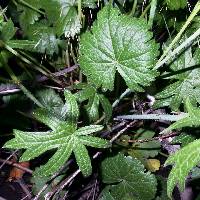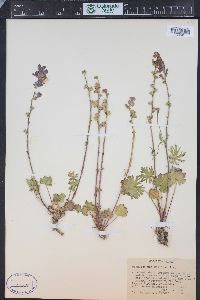|
|
 Leaves Sue Carnahan @http://swbiodiversity.org, Usage Rights: CC BY-NC (Attribution-Non-Commercial) |  Plants Colorado State University@http://swbiodiversity.org; Usage Rights: CC BY-NC (Attribution-Non-Commercial) | | | | |
|
Origin:
Native
Life Cycle:
Perennial Similar Species: Sidalcea sparsifolia
General Desc:
Upright or trailing plant with 1 or several, single or branched stems. Basal leaves are rounded. Upper stem leaves are deeply divided with lobes resembling the fingers of a hand. Many showy purplish-pink blooms grow at the top of a long flowering stem.
Identification notes: Woody base; leaves round in outline, scalloped near stem base to large palmately dissected up the stem, hairy on both surfaces; flower stalks terminal, leafless, petals 5, 1/2 to 1 inch long, purplish-pink, staminal column (united stamens) usually hairy.
Height:
To about 3 feet
Habitat Description: Usually found in moist, alkaline (salty) soils in mountain meadows, along rivers, streambanks, brooks, ditches, marshes and bogs as well as in seeps (areas where water oozes slowly out of the ground).
Plant Communities:
Riparian
Elevation: 5000 - 9500 feet
Color:
Purplish-pink
Shape:
Regular in elongated clusters
Tubular:
N
Flowering Period:
Jun - Sep
Description:
Saucer-shaped flowers with 5 petals and short, slender stalks grow on an elongated cluster of up to 20 blooms. Each petal is narrowed and white at the base with pale-colored veins. Sharply pointed leaf-like sepals below the flower are white-veined.
Leaf Color:
Dark green
Leaf Type:
Simple
Leaf Shape:
Palmate
Leaf Margin:
Lobed
Leaf Attachment:
Basal and alternate
Leaves Clasp:
N
Hairs:
Leaves and stems
Spines:
N
Leaf Description:
Basal leaves are about 2-1/2 inches wide and long: some have no lobes, some are lined by shallow, rounded lobes and some are partially divided into 5, 7 or 9 lobes. Upper leaves have 5, 7 or 9 much more deeply divided lobes resembling fingers on a hand.
Fruit Color: Reddish-green
Fruit Notes: Fruit is dry and almost smooth with a flattened sphere-like shape. When mature, it splits into 5 to 9 segments called
mericarps that are 1/8 to 1/16 inch long. Each has a fine to rough net-like side surface and is usually smooth on the back.
Seed Notes: Each mericarp has 1 seed and does not split open to release the seed when ripe. However, it does separate from the flower stem. Seeds have a bean-like shape, are reddish-brown, are about 1/16 inch wide with a small projection (<1/25 inch) at the tip.
|
|